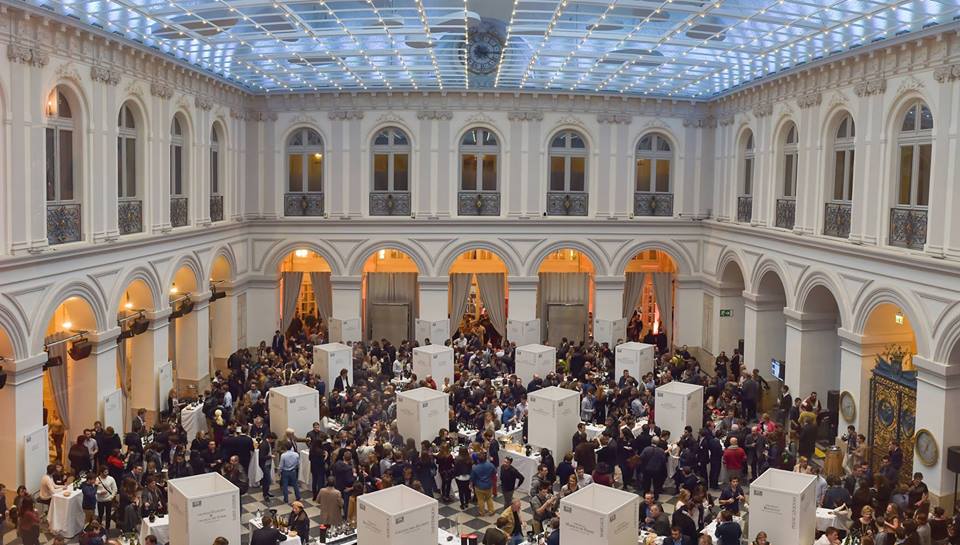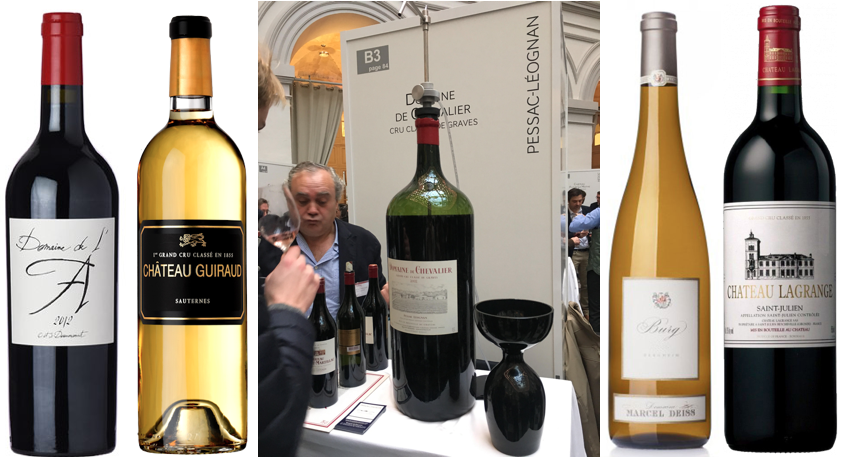Bordeaux Tasting, a review
This weekend (December 9 & 10) was the famous Bordeaux Tasting where producers from all over the world (but mainly Bordeaux) came to showcase their wines for an audience of wine professionals and paying enthusiasts. The venue was the historic Place de la Bourse in the center of Bordeaux. For me, it was a good opportunity to taste as much as possible, while writing down my own descriptions and ratings so that I’ll have a guideline for later on in my career.
Photo credit: Terre de Vins
When you have a 100+ wines to try (and spit out... or not), it’s interesting to see what you personally define as a “great” wine. Some of the wines were beautiful aromatically and then were total let-downs in the mouth. Others had supple tannins and a long mouthfeel, but were too closed in its bouquet or were smelling reduced.
For me a “great” wine must:
1) Stay true to its varietal. In other words, a Cabernet Sauvignon should not smell like tropical fruits and mangoes (*these were seriously my tasting notes from the 2015 Bordeaux blend from a well-known $125 Napa wine... it was bizarre to put it nicely).
2) Be "original." Now by this, I mean something different from the previously admonished Napa Cab Sav. I mean that the wine should have a special taste or element of the place where the vine grows. Think of the famous French word, Terroir, "sense of place." For example, it would a hard to confuse a Sauvignon Blanc from Marlborough, NZ with a Sauvignon Blanc from Sancerre, Loire Valley, FR.
2) Have enough complexity to bring the next dimension. Furthermore, its price must match its complexity in order for me to think its a good value.
3) Have a good balance between acidity, alcohol, mouthfeel, tannins, etc.
4) And most importantly – it must be tasty. Yeah, I want to enjoy drinking it.
Tasting Overview
Best wines of the night
BORDEAUX
2012 Domaine de l’A, Castillon Côtes de Bordeaux.
80% Merlot, 20% Cabernet Franc.
Now, this is the type of Bordeaux that I like to drink! I had the privledge of being served by the man himself, Stéphane Derenoncourt, the famous Bordeaux consultant and owner of Domaine de l’A. His domaine practices biodynamic viticulture with minimal oak or winemaking tricks. Derencourt said he could smell truffles in this wine and when I put my nose into the glass, I realized he wasn’t kidding! Aromatically powerful with dark cherries, long mouthfeel, and elegantly soft tannins. When you consider its price of 25-30 €, this has to be one of the best buys from Bordeaux.
2014 Chateau Guirard, Sauternes.
65% Sémillon, 35% Sauvignon.
One of the first examples of organic and sustainable viticulture and winemaking in Bordeaux. Especially in Sauternes, controlling the botryization of grapes by organic means is rare but the results speak for themselves: this wine is truly lovely. Not overly thick in the mouth; the sugar, alcohol, and acidity are in perfect balance.
2002 Domaine de la Chevalier, Pessac-Léognan.
65% Cabernet Sauvignon, 30% Merlot, 5% Cabernet Franc.
This is a very good example of an old Pessac-Léognan with aromas of candied pecans and dried red fruits, edging towards balsamic glaze. That said, it needs to be drunk now! The color and nose are already quite evolved for a 15 year old wine, and will probably start its decline in the coming few years.
2011 Chateau Langoa Barton, St. Julien.
63% Cabernet Sauvignon, 34% Merlot, 2% Cabernet Franc.
This is a 3rd Growth Grand Cru Classé owned by the same proprietors of the 2nd Growth, Chateau Léoville Barton. I actually preferred this one to Léoville Barton, probably due to Langoa Barton's higher percentage of Merlot or less new oak during aging. Regardless, the Langoa Barton has a lovely nose and great mouthfeel.
2015 Chateau Carbonnieux, Pessac-Léognan.
80% Sauvignon Blanc, 20% Sémillon.
I think this will be the first time that I’ve ever described a Sauvignon Blanc as “luscious” (that’s not from the Loire that is..). Great sucrosity and mouthfeel with a bright acidity. As a I said during the tasting, “celui-ci donne le soif.” (This wine makes you thirsty).
2011 Chateau Lagrange, St. Julien.
62% Cabernet Sauvignon, 32% Merlot, 6% Petit Verdot.
Complex wine with beautiful black fruits, graphite, and spices. Great density in mouth.
Non-Bordeaux:
2012 Domaine Marcel Deiss Burg, Alsace.
50% Riesling, 50% up to 9 other Alsatian varietals.
What a legend. We had a nearly 20 minute conversation with Jean-Michel Deiss as the line of people grew longer and longer, hoping to try his wines. Deiss is really one of the most interesting and craziest winemakers in the business. He told us that this wine, Burg, for example makes us salivate vertically and then we feel the warmth come back up and then we salivate again horizontally across our smile lines. I’ve never heard someone describe a wine in terms of how it makes us salivate but it was spot on (Ok, maybe I wanted to believe too...). "Burg" has super fresh fruit, great acidity and length. If there was ever a wine that could justifiably use the descriptor “minerality,” this one would be it! One of the most beautiful Alsatian wines or Rieslings, in general, that I have ever tried.
2015 Mas de Daumas Gassac Blanc, Languedoc.
27% Viognier, 25% Petit Manseng, 21% Chardonnay, 13% Chenin Blanc, 14% other indegineous varietals.
A very interesting and tasty white wine from southern France. Rich texture in part due to it’s week-long skin maceration. I wasn't overwhelmed by their reds but the Mas de Daumas whites were really hitting the mark for me. Seek this one out!
Not Thrillers:
2013 Chateau Latour-Martillac, Pessac-Léognan.
70% Sauvignon Blanc, 30% Sémillon.
I was really looking forward to trying the Latour-Martillac’s signature white wine but I have to say it fell a bit short for me. On the nose, it had strongly herbaceous aromas almost like a SB from New Zealand and in the mouth, it fell flat for me. Who knows? Maybe it was the vintage... I will definitely try another year of this famous Pessac Grand Cru Classé in the future.
2012 Chateau La Tour Blanche, Sauternes.
92% Semillon, 5.5% Sauvignon Blanc, 2.5% Muscadelle.
While the winemaker was very generous with his time in telling us about the “mutage” (when the winemaker adds sulfur to kill the yeast and stop the alcoholic fermentation), this Sauternes was a bit too “unctuous” for me. It had an interesting nose with the unusal addition of Muscadelle but in my opinion, the sugar was way too high and out of balance with the acidity and alcohol.
Chateau Montus, Madiran.
100% Tannat.
Ok, I honestly just don’t think I’m a Tannat person. It really is too intensely tannic for me. To exemplify this, Chateau Montus has many wines that are blended with Cabernet Sauvignon in order to soften out the Tannat. Considering that Cabernet Sauvignon is already one of the most tannic varietals, you can get the picture of how tannic Tannat actually is. As much as I love reading about the pioneering Montus founder and winemaker, Alain Brumont, and his philosophies on preservation of the soil and winemaking, I feel like I'm tasting sandpaper with 100% Tannat. I was hoping this would soften out with age but even the 1999 Chateau Montus left me seeking out the Champagnes just afterwards. There are plenty of people that love this wine but for me, Tannat is not enjoyable.
Chateau Mazeyres, Pomerol.
80% Merlot, 20% Cabernet Franc.
I was really looking forward to trying this biodynamic wine from Pomerol but it fell short for me. It had an overly fruity nose and a slightly blocky, short mouthfeel. That said it was my last wine of the day (after 6 hours) so I'm sure my perceptions were not at full-tilt either. Given its approachable price of 26.50€, I'm looking forward to trying it again with perhaps a bit more decanting (and not after 100 other wines).
Penfolds, Australia.
50% Shiraz, 50% Cabernet Sauvignon
Ok, I’ll admit that I didn’t have such high hopes for this one to begin with but since Penfolds is the example of Australian wines, I wanted to give it a try. The lower-end wines that we tried (the Koonuga Hills and Bin 51) were really over-ripe fruit bombs with notes of melted candy and the consistency of tar. The higher-end Bin 389 was slightly better but definitely not worth 65€ IMO. Maybe I've just been in the Old World too long though...
Overall, Bordeaux Tasting was a very nice (and exhausting) Saturday. I was able to taste a lot and talk to many producers about how they make wine, their philosophies, and what style they're looking for. After 6 hours of wine-tasting, I was ready to curl up in bed with a book and a big glass of ...
tea.


